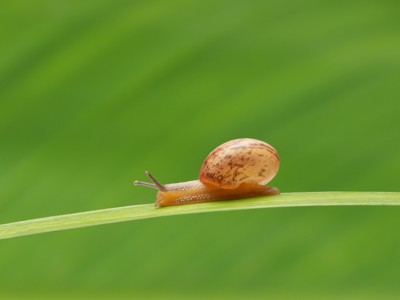
Ask the AI Tutor
Need help with Variation and Classification 02? Ask our AI Tutor!
AI Tutor - Lucy
Connecting with Tutor...
Please wait while we establish connection

A snail has an unsegmented body, that is, one body part.
Variation and Classification 02
Classification groups living things so scientists can study them more easily. From mammals to microbes, it helps explain similarities and differences in the natural world.
1 .
What do the following have in common - daffodil, grass and apple tree?
All produce pollen
No stems
Reproduce by spores
Simple leaves
All hayfever sufferers should get this correct!
2 .
Which of the following has two body parts, four pairs of jointed legs and no wings?
Beetle
Crab
Spider
Woodlouse
Spiders are arachnids. Arachnophobia is a fear of spiders
3 .
Which one of the following is found in water?
Algae
Conifers
Ferns
Mosses
Algae have no roots, stems or leaves. Some mosses grow in very wet places like a bog but they float on top of the water
4 .
How many legs do insects have?
6
4 pairs
5 pairs
More than 10
Anything with more or fewer legs is not an insect
5 .
Which is the odd one out?
Apple tree
Chestnut tree
Fir tree
Oak tree
A fir tree is a conifer, it has needle leaves and seeds in cones
6 .
Which of the following is not an arthropod?
Arachnid
Crustacean
Insect
Mollusc
Arthropods have legs, a mollusc is legless
7 .
Which of the following has an unsegmented body?
Ant
Snail
Wasp
Earthworm
The others all have more than one body part: the ant and wasp are insects with three body parts - head, thorax and abdomen; the earthworm has a segmented body all the way along
8 .
Which is the odd one out?
Bluebell
Bracken
Grass
Snowdrop
Bracken is a fern and reproduces by spores
9 .
Which is the odd one out?
Algae
Flowering plants
Fungi
Mosses
Fungi have no chlorophyll, so are not green, and cannot make their own food
10 .
Which is the odd one out?
Daisy
Dandelion
Grass
Moss
Mosses have no roots and reproduce by spores
**Unlimited Quizzes Await You! 🚀**
Hey there, quiz champ! 🌟 You've already tackled today's free questions.
Ready for more?
Ready for more?
🔓 Unlock UNLIMITED Quizzes and challenge yourself every day. But that's
not all...
not all...
🔥 As a Subscriber you can join our thrilling "Daily Streak" against other
quizzers. Try to win a coveted spot on our Hall of Fame Page.
quizzers. Try to win a coveted spot on our Hall of Fame Page.
Don't miss out! Join us now and keep the fun rolling. 🎉
**Unlimited Quizzes Await You! 🚀**
Hey there, quiz champ! 🌟 You've already tackled today's free questions. Ready for more?
🔓 Unlock UNLIMITED Quizzes and challenge yourself every day. But that's not all...
🔥 As a Subscriber you can join our thrilling "Daily Streak" against other quizzers. Try to win a coveted spot on our Hall of Fame Page.
Don't miss out! Join us now and keep the fun rolling. 🎉






